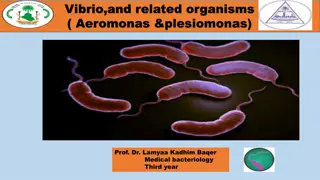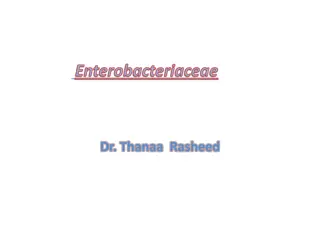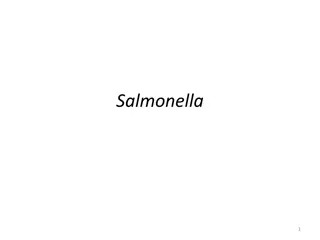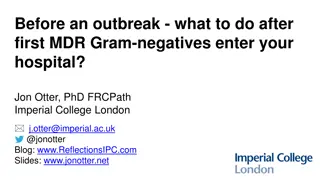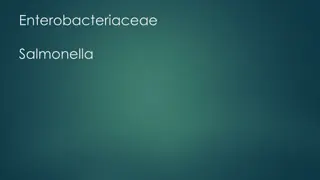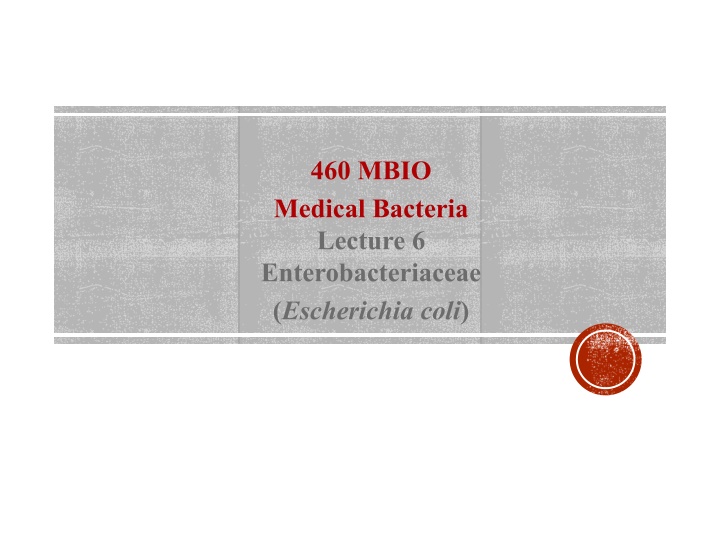
Enterobacteriaceae: Characteristics, Classification, and E. coli
Exploring the Enterobacteriaceae family, focusing on general characteristics, culture, biochemical tests, and specific details about Escherichia coli (E. coli), including its discovery, common presence, pathogenicity, and scientific classification within the domain Bacteria.
Download Presentation

Please find below an Image/Link to download the presentation.
The content on the website is provided AS IS for your information and personal use only. It may not be sold, licensed, or shared on other websites without obtaining consent from the author. If you encounter any issues during the download, it is possible that the publisher has removed the file from their server.
You are allowed to download the files provided on this website for personal or commercial use, subject to the condition that they are used lawfully. All files are the property of their respective owners.
The content on the website is provided AS IS for your information and personal use only. It may not be sold, licensed, or shared on other websites without obtaining consent from the author.
E N D
Presentation Transcript
460 MBIO Medical Bacteria Lecture 6 Enterobacteriaceae (Escherichia coli)
Enterobacteriaceae family (The enteric bacteria) General Characteristics They found mainly in the intestinal tract of human or animal either : o as normal flora non pathogenic as ( E.coli , Proteus spp. , Morganella) o as pathogenic (Salmonella and Shigella) Found in environmental sites (soil, water and plants). Facultative anaerobic bacteria. Ferment glucose with strong acid production and often gas. Can diagnosis on selective and differential media Release endotoxin from their cell wall, some release exotoxin. Most important pathogen of Enterobacteriaceae: Enterobacteriaceae includes many harmless symbionts and many pathogens, such as Escherichia coli, Salmonella, Klebsiella, Shigella, Enterobacter Citrobacter, Proteus and Serratia Morphology: Gram negative bacilli ) Short to medium size bacilli( Arrangement is single or pairs. Non-spore forming some member of this family motile ( peritrichous flagella) Some species are capsulated (developed capsule producing mucoid colony on sugar containing media) 1
Culture character: Facultative anaerobic on simple laboratory media ( ordinary nutrient media). Grow at 37 C . Media use for isolation of Enterobacteriaceae Non-inhibitory & non-differential media as Nutrient agar. Non-inhibitory but differential media such as bromothymol blue lactose agar media Differential inhibitory selective media as : 1. MacConkey agar media lactose fermenter genus: give pink color as in Escherichia coli , Klebsiella , Enterobacter (coliform bacteria). non lactose fermenter: give white color as in Salmonella, Shigella, Proteus. Coliform bacteria: member of Enterobacteraceae that ferment lactose. 2. Hektoen enteric agar media 3. Xylose lysine deoxycholate agar media (XLD media) MacConkey agar media Hektoen enteric agar media 2
Biochemical test: All of them ferment dextrose or glucose and give acid & gases after fermentation Oxidase negative Reduce nitrate to nitrite A lot of genera within the family are differentiated by their biochemical character, Specially IMViC test (Indol , Methyl red , Vogus prauskeur , citrate utilization ) Triple Sugar Iron Agar (TSI) is used for the identification of Enterobacteriaceae based on the fermentation of glucose, lactose, sucrose and the production of gas and H2S. Triple Sugar Iron Agar 3 IMViC test
Escherichia coli Theodor Escherich first described E. coli in 1885, as Bacterium coli commune, which he isolated from the feces of newborns. The most common normal inhabitant of large intestine, Found in 100% of human colon (live in host intestinal tracts of healthy and diseased people) Not all E. coli strains are pathogenic. Over 700 antigenic types (serotypes) of E. coli are recognized based on O, H, and K antigens. Scientific classification Domain: Bacteria Phylum: Pseudomonadota Class: Gammaproteobacteria Order: Enterobacterales Family: Enterobacteriaceae Genus: Species: Escherichia E.coli 4
Morphology: Most of strain are motile by long peritrichous flagella Some strain produce capsule (pathogenic strains ) Arranged in either singly or pairs. Most of spp. formed Pilli or fimbriae Culture character Aerobic & facultative anaerobic grow at 14-44 C but optimum temp. is 37 C Producing mucoid elastic colony on CHO containing media. Grow on ordinary agar media Grow on MacConkey media: Lactose-fermenting mucoid, rose pink or red colonies. On blood agar media: some strains reduced - hemolysis on Eosin methylene blue : metallic green sheen colonies. 5
Biochemical reaction: Indole test : produce indole Ferment glucose, lactose and sucrose producing acid & gases Gelatine Liquefaction Test: (-ve) Urease test: (-ve) IMViC is very important test (Indol +ve , Methyl red +ve, VP -ve, Citrate -ve) +/+/ - / - On Triple sugar iron agar media (TSI) formation of (yellow slant , yellow butt, gas positive, no H2S produced) A/A/+/- 6 indole test Urease Test Gelatine Liquefaction Test
Antigenic structure E. coli are classified into different serotypes: 1. somatic antigen ( O antigen): 171 serotype It is the polysaccharide portion of the LPS in the outer membrane. Heat stable, alcohol stable O111 & O55 is highly pathogenic. 2. Capsular antigen (K antigen): 91 serotype composed of polysaccharides Most important K1 3. Flagellar antigen (H antigen): 56 serotype protein, part of flagella heat-labile and alcohol sensitive. 4. Fimbriaeantigen (F antigen ) found in some species of E. coli especially F4, F5, F41. is a highly pathogenic type causing adhesion of organisms in the intestinal mucosa. Virulencefactors E. coli Toxins: E. coli produce two types of toxins 1. Hemolysisn 2. Eneterotoxins Heat labile (LT): resemble cholera toxin in structure & action Heat stable (ST) Verotoxin (Shiga-like toxin) 7
Pathogenesis: The most common cause of non-nosocomial urinary tract infections, wound infections, Neonatal septicemia, and meningitis, dysentery, diarrhea of infants, diarrhea of travelers, pneumonia, endocarditis, , gastroenteritis, gynecological and endotoxic shock E. coli strains causing Diarrhea: Five classes (strains) of E. coli that cause diarrheal diseases: 1. Enteropathogenic E.coli (EPEC) Do not produce enterotoxin, non- invasive. 2. Enteroinvasive E.coli (EIEC) Non-motile, non-lactose fermenting. resemble shigella, causes shigellosis-like dysentery in children in developing countries. 3. Enterotoxigenic E.coli (ETEC) causes mild watery diarrhea to fatal disease indistinguishable from cholera. 4. Enterohemorrhagic E.coli ( EHEC) Shiga toxin-producing E.coli (STEC) Cytotoxic verotoxin producing E.coli serotype O157:H7 causes mild diarrhea to hemorrhagic colitis and cause a hemorrhagic uremic syndrome 5. Enteroaggressive E.coli ( EAEC) Appear aggregated stacked brick formation. 8
Laboratory diagnosis: Sample: Urine or pus or stools Isolation on MacConkey agar media after colonies appear examines morphological and cultural character. Biochemical reaction Serological typing. Toxin production by animal model or ELISA 9

